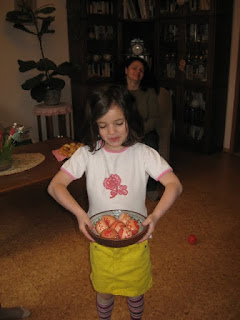Fencing
One of the things we most anticipated in moving to the Czech Republic was fencing lessons. We knew historical fencing and sword fighting were more popular here and we were lucky to find a website for a company called ARGO that offers classes in České Budějovice. So, when we came we looked them up and got registered.
Because of this, we worked extra hard. In November and December we took extra lessons with our assistant teacher, Čenda, and a very experienced young woman and fluent English speaker, Veronika. We also practiced together nearly every day. We figured the only way to gain people's respect would be to be able to defeat them in combat.
As time went on, we got a lot better. Also, the teachers seemed to be extra observant of us and did a lot of correcting, which meant we had lots of opportunity to improve. Even better was when Veronika and another young woman who speaks English very well, Bara, started going to the beginners lessons to help us out.
As Caleb and I would practice, we'd spend a fair amount of time fighting. That was my favorite. Caleb has better form and is lightning quick, but I am (despite his daily regimen of pull ups and clap pushups) still a little bit stronger. When we compete, though, he usually wins. We use wood that is about 1/2" x 1" as blades. We have no protective gear, so bruises and scrapes are common. They helped us recognize what parts of our bodies we were leaving open to attack though.
Most of our training was in the Italian School of Fencing, but we did get some demonstrations in the French and Spanish, and some time training in the German School that involved broader, double edged blades.
Back at class two things were a bit frustrating. Of course when you learn a new physical skill you go through it slowly. I understand that to develop good form, slow is critical. But we also wanted to know what it feels like going fast, especially whether it would ever work in real combat. As a result, Caleb and I were always being told to slow down. Sometimes we looked around to make sure no one was watching so we could try things fast. Really, nobody seemed to care about real combat. ARGO does historical reenactments and trains actors. So they are all about making a cool looking choreography instead of fighting. That's their thing. I would have liked more emphasis on combat though.
The other problem was that the class size was getting huge. You couldn't swing a cat without hitting someone, much less a sword. When we discussed this with the teacher, he suggested we try out the more advanced class. We did and it was so much better. The focus was more on sequences of attacks, parries, and counter-attacks. The other students were very knowledgeable and helpful.
So, what will we do to keep up fencing when we go back to Mankato? Caleb and I will keep practicing with what we know. We'll also look around (ad in the paper) and see if we can find a teacher. We'll see if we can hook up with people from the Society for Creative Anachronism (they have regular fighting practice, but it is on Sunday, which we observe as the Sabbath, so we'd need to get people together on a different day). We're also looking at the possibility of Caleb going to Sword Camp at the Minnesota Sword Club this summer. Finally, a friend has asked if Caleb would share his skills with her children, which will improve his skills and provide for more sparring partners.
The whole experience, on the whole, has been great fun and the fulfillment of yet another life long dream of mine. You can't beat that.
| Our fencing class. The fellow to the right of Caleb is our instructor, Čemla, he's fun to watch, he moves so smoothly. Bara is behind us with the black and white shirt, Veronika is two people to the right of her and next to her is another one of the assistant teachers. The other fellow who helped us a lot, Čenda, is not in the photo. From fencing |
-Peter































